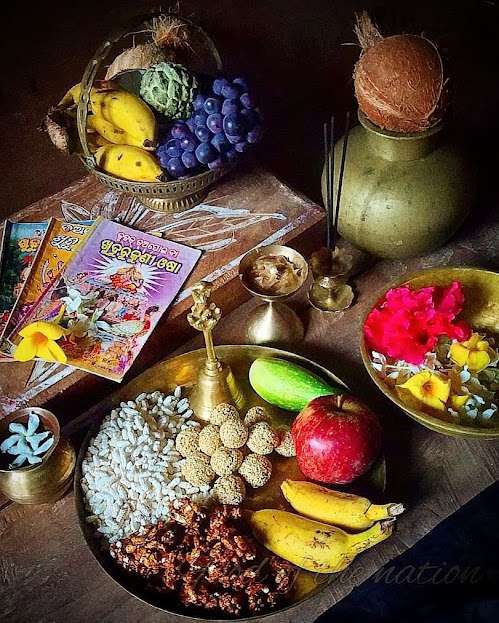I’m deliberately using “a” in place of the expected “the” in the title. There are two versions of the story of Tapoi (also spelt as “Taapoi”) that I know well and I have some idea of another. It’s quite possible there are more. One of those I know well is the story of Tapoi and the other, the story associated with“Khudurukuni Osa”. They end differently and the other differences between the storiesare motivated by their endings. The story of “Khudurukuni Osa”is very well-known, even in the parts of Odisha where this osa(ritual fasting) is not observed. I am not sure the Tapoi story I am going to narrate is known at all, except perhaps to a few. As you read my piece, you might feel that I am wasting your time by telling you what you know so well. But please bear with me. I hope you will not be disappointed.
The maritime trade of ancient Odisha forms the backdrop of the tale in surely all its versions – those which I know well and those that I do not. It is part of our collective cultural knowledge that the Sadhabas (members of the business community),of Odisha had a very profitable trade relationwith the South-east islands of Java, Sumatra and Borneo. But there is very little of this in the Tapoi stories.
Tapoi was the only daughter of Tanayavanta, a very prosperous trader and she was the youngest of the eight children he had. The child was the darling of, not just her parents, but her brother as well. She lived in luxury. She was friends with the minister’s daughter and some of the girl children of her community.Like the children of her age, they played on the swing and played making food with sand and dust.
One day, as she was playing cleaning grains with her winnow, an old woman arrived on the scene. She made a face at her and said that it did not befit her to play with such stuff as poor children play with. She should askher parents, she told her, for a golden winnow to play with and for a golden moon as well. When she told her parents about it, they called the most skilled jewellers around and asked them to make a big golden moon studded with diamonds. Soon misfortune struck. The moon was half-made when Tapoi’s father died and when it was fully made, her mother died. The funerals were observed in a manner that behoved the status of the family.
After the rituals were over, Tapoi’s brothers decided to set sail for the distant islands for trade. They made all arrangements for the family and told their wives to look after Tapoi well, indulge her in every way and ensure that she did not suffer even the slightest discomfort.The women did what their husbands had asked them to do.
One day an old beggar woman came to their house for alms. She told the eldest woman of the family that they must not indulge their sister-in-law, who was much younger to them and that all that they were doing to her wouldbring them no good.She would tell her brothers all kinds of things against them and turn them against them. They must send her to the forest to graze their goats. There, in the forest, one day or the other, a tiger or a snake would kill her. They could tell her brothers when they returned that she had died of illness.

From then on, Tapoi’s bad days started. The child was forced to wear torn clothes and was sent to graze the family’s goats in the forest. A little rice was all she was given to eat. Except for the youngest, her sisters-in-law made her life miserable. The eldest was the cruellest. Once a week, when the turn of the youngest sister-in-law came to give her food, did the girl eat her fill.
One evening it was stormy and the goat named “Gharamani” got lost in the forest. Tapoi’s eldest sister-in-law went wild. She threatened her with dire consequences if she did not bring the goat home that very night and she looked for a knife to cut off her nose. The terrified girl ran into the forest to find the goat. She shouted “gharamani, gharamani” loudly many times but to no effect.
Then with a prayer in her heart to goddess Mangala, she called for her and she heard the goat bleating. She returned home with the goat. The eldest sister-in-law cooled down a bit but did not give her food that night. The food that she gave her on the following day was so bad that the girl threw it away and starved. She decided not to return home that evening. It would be much better, she thought, to be gobbled up by a tiger or bitten by a snake in the forest than undergo torture at home day in and day out. As the night fell, she was frightened and wept aloud bemoaning her fate.
That very night her brothers returned and were still on their boats when they heard the piteous cry of the girl. They sent their youngest brother to find out who was crying and to cut a long story short, the brothers and the sister met. When they saw her piteous condition and heard from her how she had been tortured, they were furious. The following day when their wives came to the boat welcome them ceremonially, they asked them where Tapoi was. They told their husbands that she could not come because of a nasty headache. They asked their wives to go one by one and offer worship to the goddess in the boat. Dressed as a goddess, Tapoi cut off the noses of her six sisters-in- law, one after another. When the youngest sister-in-law went to her, she threw away the knife and embraced her. “I am alive because of you”, she told her,” You are my mother.”
The six women with bloodied nose decided not to return home and ashamed, they went deep into the forest, where they fell prey to a huge tiger. A few days later, Tapoi was given in marriage to a Sadhaba called Birnanchi. In terms of splendour, the wedding was nothing short of royal.
Now, friends, is this the story you knew? You might have noted that here there is no fasting, no osa, no worship of goddess Mangala with fried broken rice and the old woman and the beggar woman weren’t Brahmins. They were not from the world of the divines to intervene in the affairs of Sadhaba family. Tapoi,in this story,was no divine cursed by Indra, the lord of the gods, to spend sixteen years in the mortal world and her celestial spouse, the gandharva Chitrasena did not take her to the world of the immortals the day she completed her sixteenth year on earth. The torturers of Tapoi were not devoured by a tiger; in fact, by Lord Shiva’s grace their noses were restored. When their husbands pleaded with them to join them, they did. They were happy as was Tapoi with her spouse in the world of the divine. And who was the narrator in the story of “Khudurukuni Osa”? Lord Krishna himself!And he told the story to his spouses: Rukmini and Satyabhama.
This is what happens to a loka katha (folk tale) when it isretold in the puranic mould.
Note: The story, entitled “Tapoi Katha (the story of Tapoi)” occurs in “Lokagalpa Sanchayana”, a collection of folk tales, by Dr. Kunja Bihari Dash, published by Odisha Sahitya Akademi in 1964.
(The views expressed are the writer’s own)

Prof. B.N.Patnaik
Retd. Professor of Linguistics and English, IIT Kanpur
Email: [email protected]
(Images from the net)

